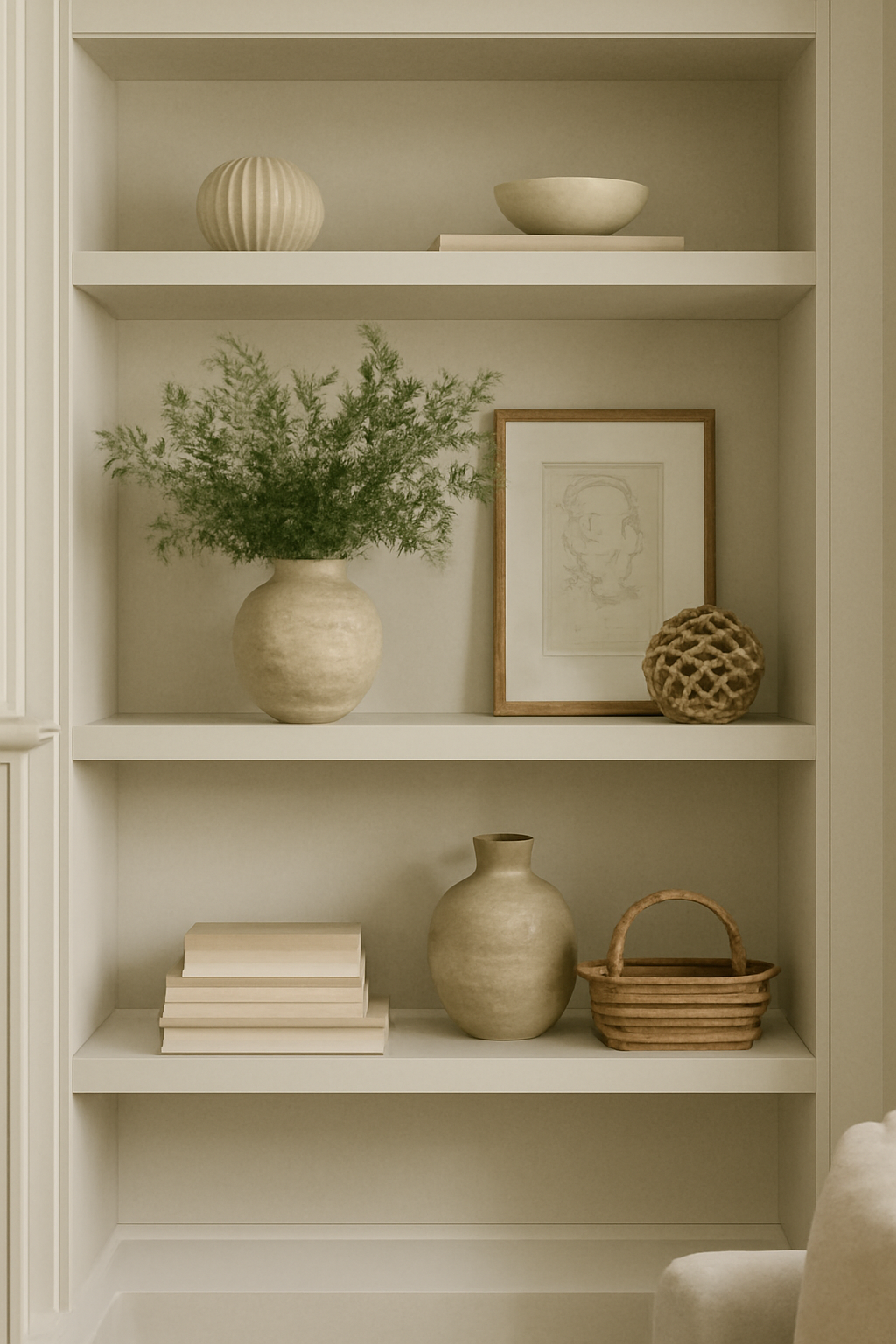Shelves are more than just storage—they’re a chance to express your personality, elevate your décor, and make any room feel curated and complete. Whether you’re working with built-ins, floating shelves, or bookcases, styling them like a professional interior designer takes more than just lining up books. It’s about balance, texture, and visual interest.
This guide will show you step-by-step how to transform your shelves into an eye-catching focal point.
Start with a Clean Slate
Before you begin styling, clear everything off the shelves. Starting fresh allows you to rethink what deserves a place and avoid clutter.
- Dust and clean the shelves thoroughly.
- Lay out the items you’re considering on a table or floor nearby.
- Remove or store items that feel outdated, mismatched, or unnecessary.
Choose a Color Palette
Sticking to a defined color scheme creates visual harmony and makes your shelves feel cohesive rather than chaotic.
- Choose 2–3 main colors and 1–2 accent tones.
- Coordinate with the room’s existing color palette for consistency.
- Use neutral tones (white, black, beige) as base colors and add pops of color with accessories or books.
Monochrome themes, earth tones, or bold contrasts can all work well depending on your style.
Use the Rule of Thirds
Interior designers often follow the “rule of thirds” when arranging objects. Instead of grouping items in even numbers or lining them up symmetrically, aim for groupings of three.
- Mix heights, textures, and shapes within each trio.
- Think: a candle, a framed photo, and a small plant.
- Leave some breathing room around each group—don’t overcrowd.
This rule keeps shelves looking intentional and balanced.
Vary Heights and Depths
A common styling mistake is placing everything at the same level. To create interest, you’ll need to play with dimensions.
- Stack books horizontally to use as a base for smaller items.
- Use tall vases, candlesticks, or framed art to add vertical interest.
- Layer items by placing smaller pieces slightly in front of taller ones.
This adds depth and prevents your shelves from looking flat or one-dimensional.
Include a Mix of Items
Great shelf styling is about variety. Too many books or too many decorative items can feel off-balance.
Here are key elements to include:
- Books: Mix vertical and horizontal stacks.
- Art/Photos: Lean framed pieces against the wall or layer smaller frames.
- Plants: Add greenery for texture and life—real or faux both work.
- Sculptural Objects: Vases, bowls, figurines, and candles add shape.
- Baskets or Boxes: Perfect for hiding clutter and adding warmth.
Think of each shelf as a mini vignette or display story.
Layer in Personal Touches
Don’t be afraid to make it yours. Adding personal items makes your shelves feel authentic and lived-in, not staged.
Ideas:
- Souvenirs from travels
- Heirlooms or antiques
- Favorite framed quotes or lyrics
- Handmade pottery or crafts
These small personal moments invite curiosity and conversation.
Balance Symmetry and Asymmetry
While complete symmetry can look formal, a bit of imbalance adds charm and dynamism.
- Use larger items like vases or sculptures to anchor the ends of longer shelves.
- Balance heavier items with clusters of smaller, lighter objects on opposite sides.
- Mirror colors or shapes from shelf to shelf, without repeating exactly.
Think of your shelves as a whole, not just individual levels.
Leave Negative Space
Don’t feel the need to fill every inch. Empty space (or “negative space”) is crucial in making shelves feel airy and sophisticated.
- Leave gaps between groupings to let them breathe.
- Avoid placing large items directly beside each other.
- A single statement object on a shelf can be more powerful than a cluttered mix.
Negative space also helps draw the eye to focal points.
Refresh Seasonally
One way to keep your shelves from becoming stale is by updating them with the seasons.
- Add seasonal colors: warm tones in fall, greenery in spring.
- Swap framed art or prints with new ones throughout the year.
- Rotate candles, ceramics, or decor accents for variety.
This keeps your home feeling fresh and aligned with the time of year.
Use Lighting to Highlight Your Shelf Styling
Proper lighting can enhance your shelf display and make it stand out.
- Under-shelf lighting or LED strips add a modern glow.
- Picture lights above the shelves create a museum-like effect.
- Candles or fairy lights can soften the ambiance in the evenings.
Even positioning your shelves near a light source or window can help bring them to life.
Stand Back and Adjust
Once your shelves are styled, take a few steps back and look at them from across the room.
Ask yourself:
- Does anything feel too heavy or cluttered?
- Is your eye naturally drawn from one shelf to another?
- Is the color palette cohesive?
Tweak items, rotate placements, or remove anything that feels out of place. Styling is a process—it’s okay to rearrange until it feels right.
Final Thought: Make It Your Own
There’s no single “right” way to style shelves. The goal isn’t to copy a Pinterest photo—it’s to create a space that feels personal and intentional. With practice and a little creativity, you can master the art of shelf styling and elevate any room in your home.
Agora vamos para o artigo 25 – “The Power of Paint: Transform a Room Without Renovation”. Vamos continuar!
